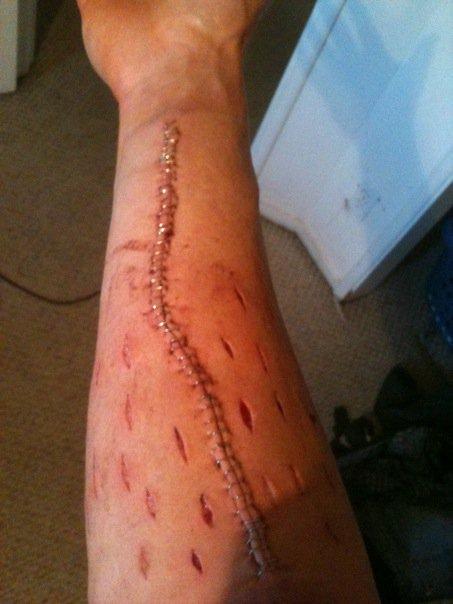This article appeared in the December 2011 issues of MXP Magazine. The majority of the content is pulled directly from the ARM PUMP Elimination System eBook that is available here at ACTIONETIX.com. Arm Pump has plagued MX, SX, Mountain Bike, Jet-Ski and thousands of other athletes that depend on their grip for success. To first read part 1 of 2 of this series that explains why arm pump happens in the first place, please click here.
Training
At ACTIONETIX, we’re literally tapped into the best and brightest minds in exercise physiology and biomechanics. From this unequalled experience and knowledge, we’ve developed a yearlong training system unique to dramatically improving overall strength, cardiovascular fitness, flexibility and of course reducing arm pump. The year is divided up into five sections that each serves a specific purpose. These five sections when put together are called Periodization. The five phases are listed below with their key points of focus:
Phase One – General Preparation
The goals of this phase include the following and lasts between 8-16 weeks.
- Rehabilitation of injuries
- Correction of asymmetries (one side stronger than the other)
- Learning exercise technique
- Development of functional muscle mass
- Improving slow twitch muscle fiber efficiency
Phase Two – Specific Preparation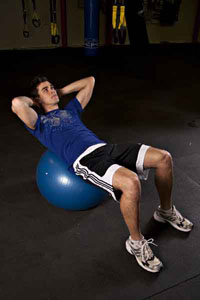
The goals of the Specific Preparation Phase include the following and lasts between 6-10 weeks:
- Increasing core strength and balance
- Increasing cardiovascular capacity and endurance
- Strength increases in key areas
- Improving flexibility
Phase Three – Pre-Competitive
The goal of the Pre-Competitive Phase is to optimally prepare your body for competition through the means of exercise and nutrition modifications. A 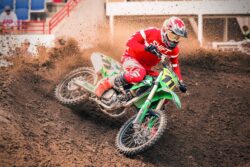 common term for this is preparing to peak for a competitive season. This is a tricky phase due to the potential to over train and loose your competitive edge both mentally and physically. This phase generally lasts between 4-6 weeks.
common term for this is preparing to peak for a competitive season. This is a tricky phase due to the potential to over train and loose your competitive edge both mentally and physically. This phase generally lasts between 4-6 weeks.
Phase Four – Competition/Maintenance
The goal during the Competitive Phase of training is to maximize competition results. The amount and type of training during this phase depends on the activity and duration of the season. Generally, maintenance training is used in order to prevent de-training (a loss of strength or cardio). Preventing over training and keeping your weight in an ideal position is important.
Phase Five – Transition/Recovery
The Transition/Recovery Phase is a 4-6 week period after the last race/competition of the season. Formal training does not occur during this phase. Staying fit by doing a variety of activities not related to the daily vigor of your training will allow you to regenerate both mentally and physically. This is a time to heal injuries with physical therapy as well as allowing your mind to decompress from competition.
Nutrition
What you put into your body has a profound effect on your performance. Eat like a pig and see how fast you go on the bike! Eat the proper amounts of protein, carbohydrates and good fats and you’ll soon feel the positive effects on your performance. Further to this, knowing exactly what vitamins and minerals to use can have a profound impact on arm pump! Gone are the days where you can simply rely on skill to win races. People everywhere are improving their diets to get faster than ever before.
Protein
When training with weights, doing cardio, as well as practicing or racing there is an incredible demand placed on your body, particularly your muscles. All of these activities put your body into a state of ‘negative nitrogen balance’. This simply means that your muscles are being broken down by all of the pounding and stress. You have to supply your body ample amounts of protein in order to recover to a state of ‘positive nitrogen balance’ for your next training or riding session. Hard-training MX athletes need to eat 1-1.5 grams of protein per pound of bodyweight per day depending on their training phase. So for example if you weigh 160 pounds and you are in the Competition/Maintenance Phase, you will need to eat between 160 and 240 grams of protein per day. A chicken breast that is the size of a deck of cards contains approximately 25 grams of protein. So to put it into perspective you would need to eat between 6 and 10 chicken breasts per day to achieve the right amount of protein.
Carbohydrates
Carbohydrates supply energy to your body and are essential for performance. Eating carbohydrates at the right time can dramatically improve your performance. Eating carbohydrates at the wrong time can trigger arm pump! I have developed a carbohydrate strategy called Reverse Compensation Loading™ that not only optimizes your fuel and energy stores, but can also dramatically reduces the onset of arm pump. In short, instead of carb loading before a race, you start carb loading immediately after a race to replenish your fuel stores. As the days pass by on the way to the next race, you are lowering your carbohydrates to a specific level so that you don’t overcompensate and trigger arm pump. This technique allows you to be fully prepared for your next race and primes your body to combat arm pump. It’s a win/win situation.
Fats
Everyone knows that to be fit and healthy, you have to limit your fat intake. Taking the skin off of your chicken, trimming your steaks and choosing extra lean ground beef are all good steps. But a certain type of fat can actually play a significant role in changing the viscosity of your blood and decreasing the risk of arm pump. There is a fatty acid called Omega-3. It is found in cold-water fish such as salmon, tuna, mackerel, halibut and lake trout. If you don’t enjoy eating fish, you can use a fish oil supplement or a flax oil supplement. Studies suggest that 3 or more grams of omega-3 per day is an optimum intake. This will play a positive role in the fight against arm pump.
Vitamin K
This is an extremely important section, so please make sure you read it! Vitamin K is a key factor in blood clotting. The USDA has established that 120 micrograms is an adequate intake each day. Excessive Vitamin K could promote the thickening of your blood, which in turn may contribute to arm pump. Spinach, broccoli, celery, blueberries and tuna and a number of other foods are all high in Vitamin K and must be managed if you’re going to minimize arm pump and maximize performance!
Supplements
I believe there is no better way to improve your performance and speed than to be in shape and arm pump free. But lets face it, you can train, eat well and get plenty of rest but you still need something to give you an edge over your 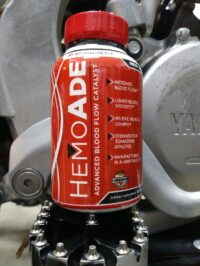 competition. At ACTIONETIX, we’ve invested hundreds of hour and tens of thousands of dollars into research and development to provide a solution to arm pump. The result of this effort is a cutting-edge sports supplement called HemoAde™. HemoAde is an Advanced Blood Flow Catalyst that is backed by clinical research showing a dramatic increase in blood flow through restrictive areas such as the fingers. By taking HemoAde once a day, you will be changing your body’s physiology, allowing blood to flow more freely.
competition. At ACTIONETIX, we’ve invested hundreds of hour and tens of thousands of dollars into research and development to provide a solution to arm pump. The result of this effort is a cutting-edge sports supplement called HemoAde™. HemoAde is an Advanced Blood Flow Catalyst that is backed by clinical research showing a dramatic increase in blood flow through restrictive areas such as the fingers. By taking HemoAde once a day, you will be changing your body’s physiology, allowing blood to flow more freely.
HemoAde also contains ingredients that increase the size and number of red blood cells, allowing you to deliver more oxygen to your working muscles. It also contains a unique ingredient called Cramp Bark, which has been used to decrease muscular cramping, which is common when racing in hot conditions. These are only some of the benefits that can be realized by incorporating HemoAde into your daily routine.
Conclusion
As I have noted, there is no better way to increase your speed on a bike than being physically fit and arm pump free. By modifying your training, nutrition as well as adding HemoFlo to your daily routine, you can literally change the way you ride. This article only the tip of the iceberg when it comes to dropping your lap times. An incredible amount of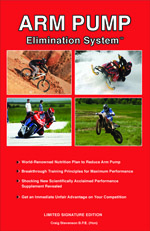 information in packed into my new book called the ARM PUMP Elimination System™. I’ve gone into real detail of how to create a training, nutrition and supplement plan that could change your riding forever. I believe this is the most valuable performance guide ever written, and it’s a big mistake if you don’t have a copy. For more details on the book or to download the PDF, simply click here.
information in packed into my new book called the ARM PUMP Elimination System™. I’ve gone into real detail of how to create a training, nutrition and supplement plan that could change your riding forever. I believe this is the most valuable performance guide ever written, and it’s a big mistake if you don’t have a copy. For more details on the book or to download the PDF, simply click here.
